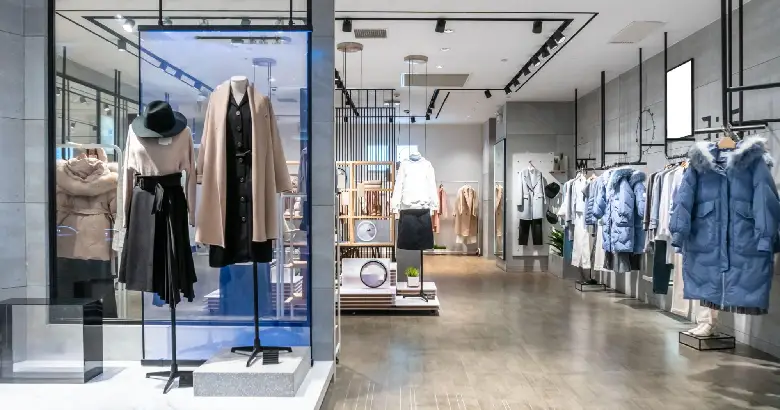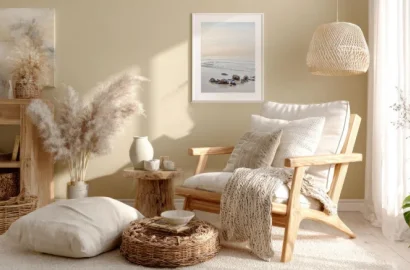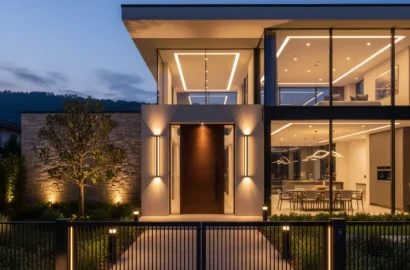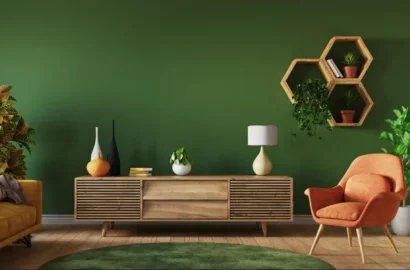Everything you need to know about shop interior design–from this year’s hottest in-store trends to best practices on creating a space that truly reflects your brand
Getting the interior design of your store right is no easy task. It needs to reflect your brand’s visual identity, support shoppers in finding what they need, and create a welcoming environment that enhances the in-store experience. This is a lot to ask of some paint and furniture!
If you’re looking to revamp your shop’s interior design, or are starting from scratch, allow us to help you out. Come along as we guide you through this important process, examining why the interior design of your shop is so crucial to your business. We also cover the core elements of effective store interior design, current trends to try out, and tips to ensure you get it right for your brand and customers.
By the end, you should feel confident in trying out some new shop interior design trends and techniques that will delight and engage both longtime customers and new visitors.
Here’s what we’ll be covering:
- The importance of shop interior design
- Key elements of effective interior design
- Trends in shop interior design for 2026
- Hands-on tips for shop interior design
- Conclusion
Ready to dive in?
The importance of shop interior design
The interior design of your store contributes to many different facets of the in-store experience. When done well, it should tick all of the following boxes:
- It’s a branding exercise, with your color choices, signage typography, and interior design style bridging the brand’s offline environment with its online counterpart and helping customers feel trust in the company, its products, and its values. Remember, the store is a physical embodiment of the brand’s visual identity and personality. Therefore, when it’s styled according to the existing brand it creates a cohesive experience that resonates with customers, reinforcing their connection to the brand and enhancing their overall shopping journey.
- It supports effective crowd control and people management, creating an accessible and seamless layout that people can successfully navigate to find the products they came in for. This involves arranging and grouping furniture and products in a way that makes sense to customers but that also inspires them to make purchases without hindering their progress through the space.
- Finally, it’s about crafting a memorable and enjoyable in-store experience that delights shoppers, encourages purchases, and sees them happy to return. This involves incorporating elements into the store that stimulate all the senses, such as music, scents, and textures. When shoppers feel at ease, they linger longer in the space and return. Immersive shop interior design also involves the inclusion of AR and VR technology which allows shoppers to experience products and services at a more enhanced level.
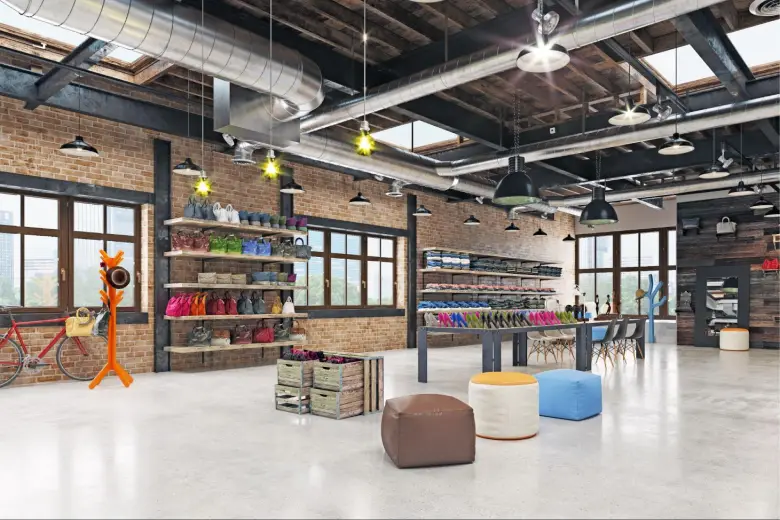
Key elements of effective shop interior design
Let’s run through the fundamentals of effective shop interior design, plus some added tips on how to make them work for you.
1. Layout and floor plan
The layout and floor plan of your store should be given careful consideration when planning the interior design of your store. It is what will determine how effectively shoppers can navigate the space and find what they need. Try to make the floor plan as intuitive as possible while promoting exploration that may lead to additional, spontaneous purchases.
2. Lighting and ambiance
Your store’s lighting plays a key role in creating an atmosphere and highlighting products. It’s important that customers can see your products and their labeling clearly, so ensure that your store is brightly lit without being startling. Lighting contributes significantly to the overall mood of the store too, so consider layering your lighting, using task lights or spotlights on products, or shelving and installing ambient lighting elsewhere to create a welcoming atmosphere.
3. Color scheme and materials
Your store’s chosen color scheme and materials should enhance the shopping experience. The right combination of colors and materials boosts the mood of customers and employees, makes the physical space appear larger than it is, emphasizes or draws attention to specific product areas or displays, and aligns the physical store with the brand’s overall visual identity.
4. Signage and branding
Signage and branding serve multiple purposes as part of your shop’s interior design.
- Clear, well-positioned signs guide customers through the store and help them find their desired products, sections, or promotions.
- Consistent implementation of the brand’s logo, typography, and colors strengthens brand recognition and familiarity due to its unified aesthetic. This builds loyalty and trust with customers.
- Effective signage is an extension of the brand’s personality, making the overall in-store experience more positive and memorable.
- Interactive signage or digital displays can enhance customer engagement, provide important information about products and offers, and create a fresh and dynamic feel.
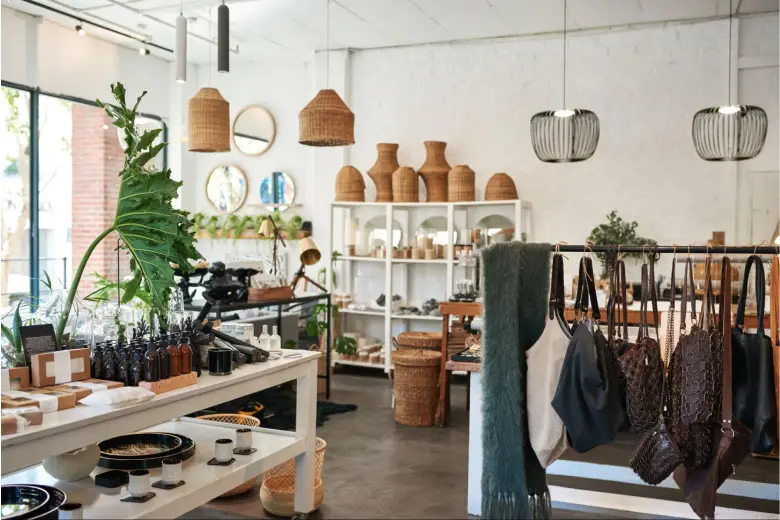
Trends in shop interior design for 2026
From personalized experiences and a focus on well-being to immersive engagement and content creation stations, the emerging trends this year are going to be all about designing the store around the customer. Let’s look at the details of these trends and a few more besides.
1. A focus on customer well-being
Trends in retail are increasingly focusing on the customer’s personal experience in the space. Stores are seeking to create a positive, tranquil atmosphere that prioritizes and restores customer well-being while they browse products. From incorporating indoor plants to maximizing natural lighting, retail spaces are embracing interior design solutions that support both body and mind.
Customers are increasingly being offered dedicated zones for relaxation, with stores recognizing the sometimes overwhelming nature of the shopping experience. Customers can take part in mindful meditation, or simply have a short time out from the hustle and bustle, with soothing colors, sounds, and scents often built into the experience.
2. Personalized retail experiences
In line with a growing focus on the well-being of customers comes personalized retail experiences. Using customer data on personal preferences, buyer behavior, and shopping history, physical stores are curating in-store experiences that meet each customer’s desires and needs.
Customer-centric layouts and technology-driven customization will come to the fore here, with stores tailoring both product recommendations and in-store customer experiences. We’re likely to see many more stores embracing interactive displays, QR codes, personalized product packaging, and even bespoke app-based shopping assistants, supporting customers in finding what they need and offering relevant suggestions that are both unique to the individual and pertinent to their tastes.
Digital tools will also enable stores to give their shoppers personalized offers on their favorite products. This use of technology and data is not just an effective way of enhancing the retail experience and boosting customer satisfaction but also serves as a bridge between a customer’s online and offline experiences with a brand. This coherent approach across physical and digital stores boosts customer trust, loyalty, and confidence in a brand, encouraging repeat visits and sales.
3. Content creation studios
Thanks to the power of user-generated content as a marketing tool, content creation studios are set to be huge this year. These dedicated spaces are for content creators and influencers to create, stage, and shoot content, such as photographs, videos, and even product reviews, for social media, blogs, and websites. The idea behind these studios is to encourage shoppers to create and share personalized content that reflects positively on the brand and attracts more potential customers to the store.
While these content creation studios will vary significantly from store to store in terms of size, layout, and equipment, many are likely to provide cameras, lighting, professional backdrops, and editing tools to encourage creativity and product engagement, making it as easy as possible for customers to make and share brand-related posts.
4. Sustainability
We’ve seen sustainability become increasingly important to consumers across all sectors in the last few years. The retail sector is no different, with customers placing high expectations on their favorite brands for using and promoting sustainable practices in their stores.
Just some of the ways stores are likely to increase their sustainability over the next twelve months include:
- Introducing energy-efficient lighting solutions
- Reducing waste
- Using biodegradable or recycled materials for items such as carrier bags and packaging
- Incorporating solar panels
- Emphasizing circular economy principles
Informative signage about sustainability efforts

4. Minimalistic merchandising
Aligning with home interior design trends, stores will be embracing minimalistic merchandising and layouts in 2026. Seeking to highlight product quality over mass production, stores will highlight simple, carefully constructed displays, clean lines, neutral colors, open spaces, and uncluttered designs that direct customer attention to the products. Think: lots of floor space and carefully curated, artistic displays instead of crowded shelves or excess decoration.
There are a few benefits to adopting a minimalistic approach to merchandising. It reduces stress levels by mitigating visual or cognitive overload, making it easier for customers to find what they are looking for. Customers can get easily overwhelmed in busy shopping outlets. By streamlining product displays and giving everyone a bit more room to breathe, customers can find what they came for more easily, get less distracted, and feel more positively about the brand; all thanks to a more calming overall experience.
5. Immersive brand experiences
These days, every brand worth its salt knows that customers expect much more from their physical and online shopping experiences than they did even ten years ago. Immersive experiences is one key area in which retail environments are rapidly transforming. Instead of simply offering products and services, brands are increasingly inviting customers to engage with their products on a deeper, more sensory level using immersive technologies such as AR (augmented reality) and VR (virtual reality). These interactive tools enhance experiences and strengthen engagement between a customer and brand, supporting and improving their in-store experience. The following are just some of the ways brands are using these technologies to offer exciting experiences:
- Virtual try-on for clothing, shoes, and accessories
- Furniture visualization that enables users to see the products in their own homes before purchasing
- VR car showrooms that allow users to explore different car models and types virtually
- Interactive product customization that allows users to see their own designs on products before deciding to buy
- Virtual home tours that inform furniture and homeware purchasing decisions
- AR-assisted shopping that gives users more information on the products they are browsing in real-time
6. Digital displays
We’re likely to see many more digital displays tucked seamlessly between the clothes racks or nestled discreetly among the food aisles as we look to future trends of store interior design. Why? Well, these high-tech screens are set to enhance every part of the retail experience, from showcasing real-time product information to displaying tailored promotions based on a customer’s behavior, preferences, or shopping history.
As well as being a dynamic and useful resource that provides important and pertinent information about a store’s products and services, digital displays also help stores keep the shopping environment fresh and engaging for customers. From accessing time-limited discounts to getting personalized recommendations, digital displays are set to offer customers even more innovative ways to engage with their immediate surroundings, visualize their options, and uncover new and exciting products that meet their desires and needs.
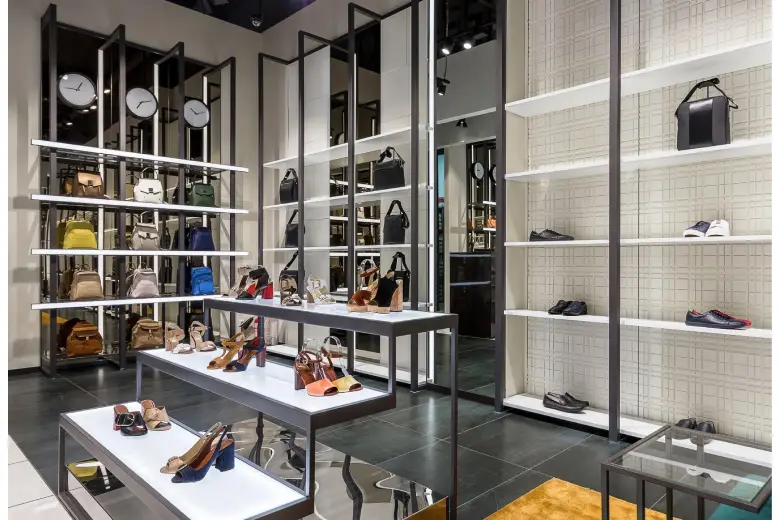
Hands-on tips for shop interior design
Check out these practical ways to revamp your store’s interior design and make a positive impact on your footfall and sales.
1. Be selective with your color palette
The colors you choose for your shop’s interior design serve different purposes. They should:
- Complement and enhance the products on display
- Support the atmosphere you are trying to create
- Align with the brand’s visual identity
To achieve these objectives, stick to just a few key colors for your store’s paint, wallpaper, furniture, and accessory choices. If you try to combine too many colors or patterns, you may overwhelm visitors or give a chaotic impression. Neutrals are a great choice if your products are visually bold, while the odd statement piece in a bright color can draw customers’ attention to a promotion or an overlooked area of the store.
Be sure to select a range of colors already in use on company branding materials. This will help to create a cohesive brand experience for customers, connecting their online and offline experiences. This also boosts familiarity and loyalty among customers, whereas using colors that don’t align with the brand’s existing visual identity will confuse customers and erode trust.
Finally, consider the impact that different colors can have on customers. While red, for example, is often associated with romantic love, it is also associated with rage. Colors also have different meanings in different cultures and countries. Be sure to research the cultural connotations associated with your color choices before making a decision about your store’s color palette.
2. Optimize your product displays
For customers to find the products they’re looking for and be inspired to make additional or unplanned purchases, you’ll need to optimize your product displays.
To curate the sort of visually engaging and organized layout that encourages sales, try out the following techniques:
- Curate a visually engaging and organized layout
- Group similar items together
- Tell a story with your product display by placing items that might be used together in a configuration that inspires customers. E.g., Display a sunhat and sunglasses alongside suncream and a beach mat.
- Place seasonal or promotional items at optimal locations such as at the end of aisles
- Light your product displays to draw attention and highlight key features
3. Ease shoppers in gently
A false move many retailers make at their store entrances is to try to engage shoppers using very bold colors, dramatic signage, or daring product displays as soon as they’ve set foot in the space. Although it’s no bad idea to incorporate eye-catching designs in the interior design of your store, it’s a mistake to overwhelm shoppers at this initial engagement point as it can often scare them off.
Instead, it’s important to ease shoppers into the space gently. Use soft lighting, calm or neutral colors, and inviting signage that does not try to communicate too much. This will feel inviting to shoppers without coming across as insistent or aggressive. Simple, clean displays often work much better than chaotic, brightly-colored ones, as they encourage shoppers to explore at their leisure without feeling rushed to make a purchasing decision.
A good approach is to create a pleasant sensory experience for your customers as they take their first few steps through the door. Place key products at eye level, play relaxing background music, and offer product samples within easy reach. By providing a memorable yet comfortable interaction with your brand at this early stage, customers are more likely to travel deeper into the store and make multiple visits.
4. Make the most of your ‘power wall’
The “power wall” in retail is the industry term used to describe the first prominent display area visible to shoppers as they come into the store. It’s a crucial space for showcasing new products, promotional items, seasonal specials, or top sellers, as it catches customers’ attention the moment they walk in.
Due to the high volume of traffic that will walk past your ‘power wall’ and browse the items displayed there, it’s important to make the most of this space. You can do this by using spotlights, bold signage, and bright colors, keeping it well-stocked with new and exciting products, and telling a visual story with your product displays that inspire customers to make purchases.
Conclusion
In this article, we’ve taken a deep dive into the value that effective store interior design can bring to your business. While it’s important to study trends and stay knowledgeable of evolving customer preferences, try not to overwhelm shoppers with too many styles or ideas. Instead, stay true to your brand’s visual identity and opt for interior design trends that align with your existing values and products.
For example, if your shop sells natural beauty and wellness products, customers will be drawn to sustainable materials and an eco-friendly approach to packaging. However, if such a store is filled with interactive screens you may find this does not evoke the right atmosphere for customers.
Whichever ideas you decide to experiment with, let your brand and ideals guide you. When this is done effectively, your store will feel fresh and current to customers without losing any of its authenticity.
If you’d like to learn more about interior design, head over to AND Academy’s blog for more insightful and inspiring articles like this one, or consider taking an interior design course for a comprehensive education in this rewarding, creative, and impactful design field. You can also check out this project by AND Learner, Ishani Pati for inspiration.
Still weighing up your options? Then keep exploring with these guides:
- What Is Visual Communication Design and What Does a Visual Communication Designer Do?
- A Comprehensive Guide To Minimalist Interior Design And How To Make The Most Of It (With Ideas)
Next Steps
In case you need further assistance, here are some resources to consider:
- Watch this session by Snehanshu Mukherjee, Founding Partner at T.E.A.M and Mansi Almadi, an Interior Designer at Studio Lotus
- Talk to a course advisor to discuss how you can transform your career with one of our courses.
- Check out our Interior Design courses – all courses are taught through live, interactive classes by industry experts.
- Take advantage of our scholarship and funding options to overcome any financial hurdle on the path of your career transformation.
Note: All information and/or data from external sources is believed to be accurate as of the date of publication.

